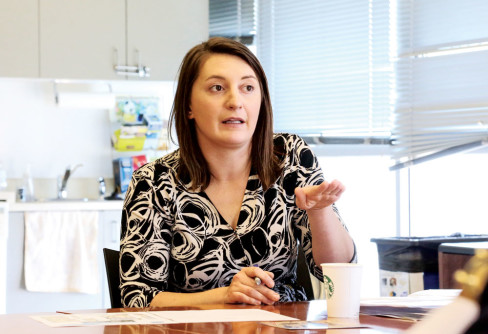A meeting to air frustrations about lack of progress in meeting Stapleton’s affordable housing goals moved quickly to common ground on the daunting challenges facing housing activists and builders. At an unusual five-party meeting April 14, members of the Stapleton Citizens Advisory Board (CAB) expressed their frustrations to Forest City, the Stapleton Development Corporation and Denver city staff.
As it turns out, Stapleton’s shortcomings in this area parallel those of Denver as a whole. Stapleton’s Green Book requires 10 percent of its for-sale units to be affordable for people earning 80 percent or less of the area median income (AMI) and for one-third of its total housing to be rental units. At two-thirds build-out, for-sale affordable in Stapleton stands at 5.1 percent with rental at 19 percent. Meanwhile, city staff said Denver has 87,000 households at 80 percent or less AMI and a shortage of 30,000 dwellings for those who are “cost-burdened,” i.e., pay more than 30 percent of their income for housing.

Laura Brudznyski, Denver OED
At the April 14 meeting, long-time CAB member Alice Kelley lamented that people such as her daughter, a teacher, cannot afford to live in Stapleton. CAB member Jim Wagenlander said, “We’re falling short and we’re not keeping pace.”
Stapleton’s two most active affordable housing providers detailed the challenges inherent in financing affordable housing projects. For-profit developer Gene Myers of Thrive Home Builders said he has had to cross-collateralize his affordable housing project loans with his market-rate developments. He has even had to take out personal notes: “The bank gets my house if this (affordable housing project) doesn’t work.” Gete Mekonnen of Northeast Denver Housing Center (NEHC) said it took three years and seven layers of financing to get the 84-unit Northfield Apartments project going.

Gete Mekonnen, NE Denver Housing
Myers and Mekonnen lauded Forest City’s commitment to affordable housing with Myers saying his company is “alive because of Forest City. They worked with us through the recession. It pains me to see what I think is the distrust between you (CAB) and Forest City because I was there, all the way through the recession. Guess what—they fell behind. Did anyone’s plan not fall behind during the recession?”
Following presentations by Forest City, Thrive and NEHC, CAB member Jim Wagenlander said, “There is no ill feeling to you (the two builders) or Forest city. Stapleton is wildly successful. The problem is it’s not the diverse community that was planned for. Stapleton is not diverse, it is gentrified.” Housing Diversity chair Damon Knop thanked the presenters and said, “Ten years of mistrust ends here today.”
Myers said the issue of affordable housing is “complex and grave,” arguing for more emphasis on housing needs for those earning 0 to 30 percent AMI. Once land is secured, Myers and Mekonnen said the great need is for gap financing.

Gene Myers, Thrive Home Builders
Laura Brudzynski, of Denver’s Office of Economic Development, said Denver staff will be proposing to City Council two funding sources for adoption later this summer: a property tax increase of up to one mill, and a “housing linkage fee” that would be a one-time payment by commercial and residential developers. Myers cautioned such a fee for builders will raise the cost of market-rate homes. The city goal is establishment of an annual revenue stream of a minimum of $15 million to support creation of 6,000 affordable units over the next 10 years.
SDC Chair Kevin Marchman said he would recommend to his board a follow-up meeting between the builders and CAB to decide on a specific course of action to help meet the Green Book’s affordable housing goals.



0 Comments